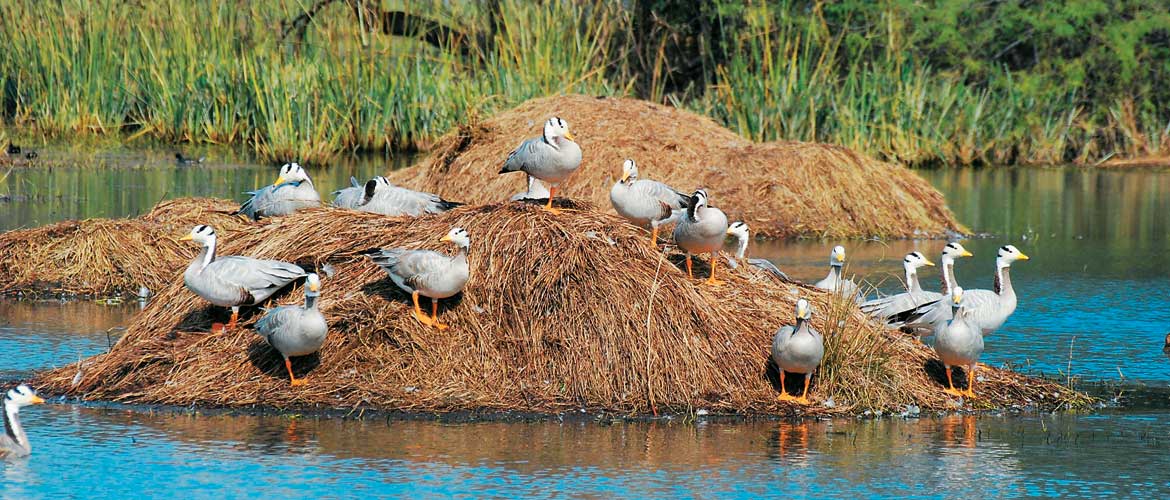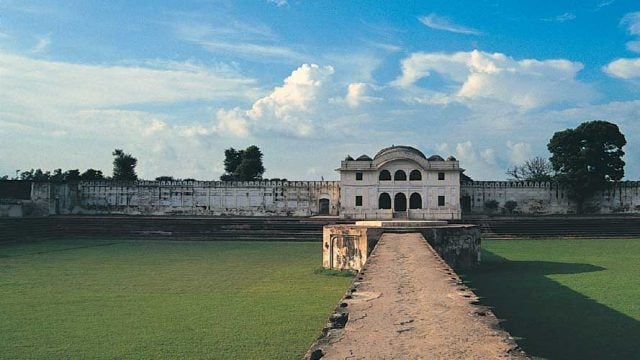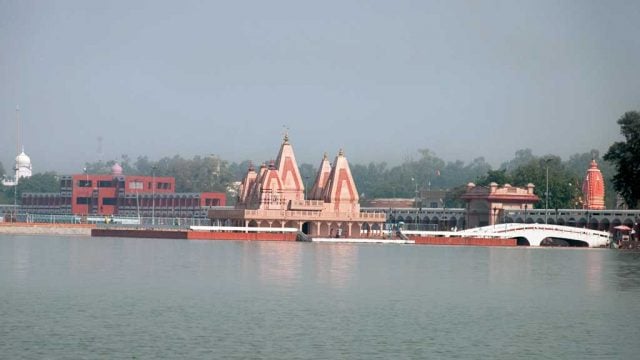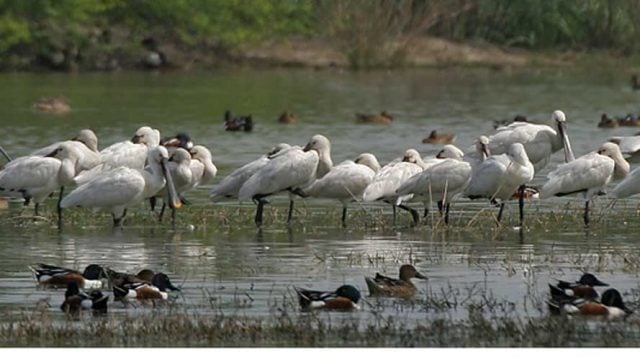Winter is the prime time for birdwatching in Sultanpur. If you live in New Delhi
Watching the arrowhead formations of gargeny (amongst the first ducks to arrive here) and then the way they tumble topsy-turvy into the lake is a delight. Other species that follow include shovellers, pin-tails, common teals, mallards and wigeons. And if the water is deep enough, then common pochards as these are the ‘diving’ rather than ‘dabbling’ ducks. If you are lucky, you can also spot the ferruginous ducks, also called fudge-ducks. They are found across Eurasia.

The sanctuary also attracts both the species of geese – greylag and bar-headed – which are often spotted wandering the national park all night, and then enjoying the morning sun by the lake. Big battalions of cranes and great white pelicans usually visit the lake by late afternoon. If you are lucky, you may spot them departing just before dawn.
Scuttling on the mudflats, along the banks of the lake, are the salt and pepper waders, which are difficult to identify. These shy birds are prone to occupying spots behind tall shrubs. Little stints, on the other hand, chirp near the lake shores and enjoy the company of common red-shanks (which have reedy red legs), sandpipers and white-tailed plovers. European lapwings, with their kohl-lined eyes and iridescent green plumage, add a bit of class to the group. Large flocks of ruff (boasting brown and beige feathers) seem to use the waterbody only as a transit halt on their way further south, and then on their way back north in spring.
The grasslands towards the south of the national park are usually abound with larks and wagtails, scuttling after insects. The marsh harrier sweeps low and menacingly over the grassland, while bonelli’s eagle usually keeps watch from its favourite stump. Other raptors you can spot here include the greater spotted eagle, lesser kestrel and the osprey. The acacia woodlands of Sultanpur National Park also play host to black redstarts, red-throated flycatchers, grey-headed canary-flycatchers and long-tailed minivets both in scarlet and black feathers, as well as the lesser whitethroat.
In years of good rainfall (which are few and far between), the sanctuary has recorded a headcount of around 20,000 birds from October–March, while in those with scanty rainfall (such as 2000–2003), the figure did not even cross 3,000.
Once winter ends, the guests start preparing for their journey back home. The atmosphere in the park changes considerably in spring (March–April). There is an air of urgency. The waterfowl practice sorties overhead, preparing for their journey back north. On the lake bed, the red-wattled lapwings and black-necked stilts (both residents of the park) start showing signs of paranoia, for now they have to brace themselves for the upcoming summers, the scorching heat of this region is truly uncomfortable.
Also in the woodlands, other residents start looking for partners and accommodation; sleekly tuxedoed magpie robins take part in a mellifluous concert to compete for the attention of sloe-eyed females. Pied mynahs, brown-faced barbets and coppersmiths busily excavate nesting holes, wren-warblers and tailorbirds shout from the bush-tops as if they’re electioneering, and even the deadly grey shrike, with its bandit mask warble love numbers!
Small bee-eaters float on sharp triangular wings, trilling musically, and even Indian rollers leap about, emitting guttural whoops of delight. White-throated kingfishers let loose their ringing ‘ki-lil-lil’ warnings from treetops before rushing after some unfortunate frog or gecko.
Summer commences in April and lasts till the end of June. The time for song and dance is over, and the stern business of raising families is on. Orioles sing ‘pee-lo-lo’ as they flit between the trees. The woodlands may see a sudden influx of red-turtle doves, which construct their skimpy nests in the acacias. The lapwings and stilts become neurotic – get close and you can be subjected to a dive-bombing attack.
July to September are Sultanpur’s most crucial months, for the amount of rainfall determines the extent to which the lake will remain filled in winter. (It has been sought that this dependency be reduced by bringing water from a nearby canal via a pipeline. However, even this supply is erratic.) Soon after the first downpour, a mantle of new grass covers the cracked lakebed. In the woodlands, you can spot the flycatcher flaunting its snowy tail streamers, while in the grasslands, the zitting cisticolas (which have caramel and chocolate chip markings) leap and sing. At the grassy fringes of the lakebed, the little grebes or dab-chicks trill like animated alarm clocks while building their nests.
The big grey cranes are struck with the romance of this season. At this time, flocks of blue-cheeked and blue-tailed bee-eaters show up, calling out in their deep contraltos, accompanied by the chorus of sleek wire-tailed swallows dressed up like sailors! The acacia-clad islands turn into busy nesting colonies, as egrets (in white lace), cormorants (in black satin), darters (in ebony and silver) and pond herons (all maroon taffeta no less) get surrounded by bumbling black-headed white ibises (always appearing late) and goofy-looking painted storks.
The gimlet-eyed black-necked stork too may be spotted, sometimes a pair accompanied by a tardy adolescent. (They nest on big trees, outside the park.) Comb ducks, in iridescent purple and with ink-spattered faces, and resident spot-billed ducks (with kohl around their eyes), fly urgent sorties over the lake, quacking hoarsely. By the end of September, the skies are blue once more and the first of the migratory arrivals splash down. Carry a pair of binoculars for a better view of birds.
ABOUT SULTANPUR NATIONAL PARK
Spread across 1.42sq km, Sultanpur National Park has been attracting birds for over 100 years. Over 320 species have been listed here (almost one third of the species in the country). The potential of this vibrant national park was highlighted in 1969, at the Conference of the IUCN (World Conservation Union) in New Delhi, thanks to the efforts of Peter Jackson (a journalist-turned conservationist at IUCN).

The area was declared a sanctuary in 1971, and upgraded to a national park (the only one in Haryana) in 1991. The ‘lake’ in the park was formed by a natural depression in the ground that got filled up by rainwater and the water overflowing from the surrounding areas. The water is highly saline. However, due to fencing and construction of farmhouses in the vicinity of the park, the ingress of water has stopped and the water table has dropped considerably. After a long, dry and barren period during the 1990s, water is now being brought via a pipeline from a nearby canal, but even this supply is not assured as problems of one kind or another keep cropping up.
However, Sultanpur lake was always a seasonal and not a perennial water body.
ORIENTATION
The entry gate of the park is to the left, off the main Gurgaon-Farrukh Nagar Road, 3km from Chandu village. The parking facility is near the entry gate, which leads both to the sanctuary and the Rosy Pelican Tourist Guest house. The complex also houses the Forest Department Office. A circular road starting from the entry gate circumambulates the sanctuary area. Several watchtowers mark this path. A museum, an interpretation centre and a library are located at the entrance, across from which is the ticket booth.
◆Entry Indians ₹5; Foreigners ₹40 Timings 7.00am–4.30pm Vehicle parking fee ₹10 Camera Still ₹25; Video ₹500
THINGS TO SEE AND DO
For birdwatching, carrying your binoculars is absolutely essential. If you are starting out early in the morning, a walk around the lake in a clockwise direction is advisable; the direction of the sun’s rays will also be conducive for clear viewing.
A bund, broken in sections, runs around the lake. This is the best spot for birding. For spotting birds in the southern part of the park, choose a spot near the fences. It is good for viewing Indian coursers (which visit in winter) such as chestnut-bellied sandgrouses, Hume’s short-toed larks and ashy-crowned finch larks.
Museum and library
Situated within the park is a museum cum library that has a good stock of books on wildlife. The museum has photographs of the birds that visit Sultanpur. You can also find plenty of information on the routes of the migratory birds visiting the park.
Things not to do
Remember, Sultanpur’s first priority is conservation of the ecosystem, not attracting crowds for picnicking, it is an important refuge for winter migrants and the interests of the birds must always take precedence. Therefore, maintain silence inside the park. Do not organise birthday parties, picnics, cricket matches on the lawns, which most tourists come here to do in winter. Do not ‘chase’ the birds on the lake bed (people have done this too).
WHERE TO STAY AND EAT
The Haryana Tourism Development Corporation has 14 rooms at the Rosy Pelican (Tel: 0124-2015670; Tariff: ₹1,900–2,500) at Sultanpur. It has a restaurant and a bar, and vast lawns. It has the added advantage of being located within the park complex. The restaurant at Rosy Pelican TRH serves both vegetarian and non-vegetarian fare.
AROUND SULTANPUR
Basai (8km)
On the road to Gurgaon from Sultanpur (turn left just before the railway crossing) is Basai, a once-wonderful little wetland that gave Sultanpur a run for its money, with 240 species notched up in just two years. Unfortunately, the ingress of water into this little swampy area has been blocked and the place has all but dried up. It’s best to get here by your own vehicle.
Bhindawas Bird Sanctuary (35km from Gurgaon)
About 45 minutes from Sultanpur and about 80km from Delhi, the sanctuary is best approached via Jhajjar and Chhuchakwas. It comprises 1,000 acres of wetlands and an 11-km-long motorable bund that runs around the water body.
Tip Make a day trip from Delhi or Gurgaon, or stay at Rosy Pelican in Sultanpur Bird Sanctuary.
GETTING THERE
Air Nearest airport: Indira Gandhi International Airport, Delhi (35km/ 1.5hrs) is well connected to all Indian cities. Taxi fare is ₹1,200–1,500
Rail Nearest railhead: Gurgaon Station (15km/ 30mins). Taxi as above
Road From New Delhi take NH8 to Gurgaon. Follow signboards to Farrukh Nagar/ Sultanpur, past Chandu village (3km from Sultanpur). It’s best to travel by your own vehicle
Tip Haryana Tourism offers package tours. For schedules and rates, call Haryana
FAST FACTS
When to go Open all year round but best sightings are from October–March
Wildlife/ Forest Dept offices
Inspector (WL)
Sultanpur National Park
Gurgaon-Farrukh Nagar Road
Gurgaon District, Haryana
Contact: Rosy Pelican TRH
Cell: 08901554731
Chief Wildlife Warden (Haryana)
Sector 9, Panchkula, Haryana
Tel: 0172-2583682
STD code 0172
State Haryana
Location Sultanpur, along the Gurgaon-Farrukh Nagar Road
Distances 15km W of Gurgaon, 50km SW of Delhi
Route from Delhi NH8 to Gurgaon, Farrukh Nagar road to Sultanpur National Park
North Zone
OT Getaway Guides
Sultanpur National Park





